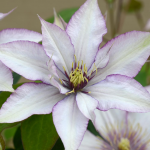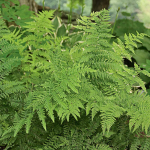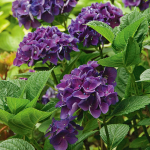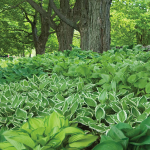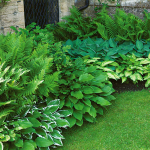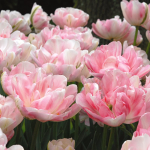Product Details
Bright red feathered with a yellow edge, a carnival of color all by itself. A bed full of our large red-and-yellow perennial Tulips is a knockout. Midseason.
After testing for a score of years in Holland and America, a series of Darwin Hybrid Tulips has proved to provide up to 3 years (sometimes more) of splendid bloom, with bud counts actually increasing for the first 3 years. Though they will never have the permanence of Daffodils, this group far surpasses the performing life of Tulips as we knew it. Our Perennial Tulips are not only for the garden; they can be naturalized, which is hard for gardeners to believe.
We ship extra-large bulbs that will bloom magnificently next spring and for many to come, provided they receive the basics of good culture: plant deeply; feed with a balanced fertilizer in fall and then again in early spring; remove the flowers as soon as they go by; and avoid watering them in summer. Your reward will be more than ample.
For information on the growing and care of Tulips, click Growing Guide.
Shipping
HOW PLANTS ARE SHIPPED
The size of the plants we ship has been selected to reduce the shock of transplanting. For some, this means a large, bareroot crown. Others cannot travel bareroot or transplant best if grown in containers. We ship these perennials and annuals in 1 pint pots, except as noted. We must point out that many perennials will not bloom the first year after planting, but will the following year, amply rewarding your patience. We ship bulbs as dormant, bare bulbs, sometimes with some wood shavings or moss. Shrubs, Roses, vines, and other woody plants may be shipped bareroot or in pots. The size of the pot is noted in the quick facts for each item.
WHEN WE SHIP
We ship our bulbs and plants at the right time for planting in your area, except as noted, with orders dispatched on a first-come, first-served basis by climate zone. We also ship a wide range of containers and planters, tools, supplies, fertilizers, garden wear, garden decor items, as well as indoor decorations like wreaths and dried bouquets when available. Estimated dates for shipping are indicated in the green Shipping Details box for each item. Please supply a street address for delivery. Kindly contact us with two weeks notice, if you'll be away at the expected time of delivery.
OUR GUARANTEE
We guarantee to ship plants that are in prime condition for growing. If your order is damaged or fails to meet your expectations, we will cheerfully replace or refund it. Please contact our Customer Service Department at 1-800-503-9624 or email us at [email protected]. Please include your order number or customer number when contacting us.
Reviews
Average Customer Rating:
 (3 Reviews)
Write a Review
(3 Reviews)
Write a Review
Sort by:
Beautiful - looks like photo 
A viewer from Upstate NY
4 of 4 people found this review helpful. Do you? yes no Certified buyer
Fantastic! 
A viewer from Worcester, MA
Beautiful but not as pictured 
A viewer from Colorado Springs, CO
20 of 20 people found this review helpful. Do you? yes no Certified buyer
Growing guide
These indispensable bulbs have been enjoyed in gardens around the world for centuries. Tulips today are available in many shapes, sizes, and seasons of bloom and the smart gardener can have Tulips blooming from early spring through May in a multitude of colors. For the best display, avoid the "soldier effect" and plant the bulbs in clusters. Plant large bulbs 5–6″ apart and smaller bulbs 2–3″ apart. Small Species Tulips are ideal for rock gardens and the tall, large-flowered varieties can hold their own anywhere.
Bulb size: 12 cm /species 5-10 cm
Light/Watering: Tulips perform best in full sun in the North and will tolerate very light shade in hotter areas. Unless the season is unnaturally dry, normal rainfall should suffice.
Fertilizer/Soil and pH: Tulip bulbs require a well-drained soil. Sandy soil enriched with organic matter is ideal as is a pH of 6.0 to 6.5. Keep Tulip bulbs cool (below 65°) until ready to plant. Plant in fall at least a month before the ground freezes. Follow directions for planting depth for individual varieties. Many Tulips (the midseason and late-flowering varieties in particular) tend to bloom magnificently the first spring or two after planting and decline thereafter. Species Tulips, Darwin Hybrids, Fosterianas, Greigiis, Kaufmannianas, and WFF Perennial Tulips can put on a stunning display for several years with your help:
- Plant at the depth recommended on the plant label (or slightly deeper); we recommend you plant large bulbs 8–10″ deep, smaller bulbs and species Tulips 5–6″ deep.
- Remove blooms (on all but the species Tulips) as soon as they fade to prevent the formation of seeds.
- Allow the leaves to yellow before removing them.
- Fertilize in fall and early spring with any of our fertilizers specifically formulated for bulbs.
- Tulips will also perform more reliably if they are not watered during their summer dormancy.
Most early and midseason Tulip varieties are excellent for forcing. Rooting time is from fourteen to sixteen weeks. More information on forcing bulbs may be found on our Web site.
In parts of the country where winters are mild, Tulips may not receive enough natural cold to stimulate proper growth and flowering. We recommend treating these as annuals and replacing them with new bulbs every year. Check with your local USDA Cooperative Extension Service to find out whether any bulbs require prechilling before planting in your area. Place the bulbs in a refrigerator, away from fruits and vegetables (these produce ethylene gas, which can harm the embryonic flowers inside the bulbs). Make sure the bulbs remain dry. The usual prechilling time is ten weeks or longer at 40 to 45°F. Once the bulbs are removed from cold treatment, plant them right away. Bloom occurs about six to eight weeks after planting. Discard the entire plant after bloom.
Please note: An amber gel-like substance called gummosis is sometimes present on Tulip bulbs. It is not harmful and will not affect the bulbs' performance.
Pests/Diseases: Aphids may be a problem, but are easily washed off with a water spray. If you notice spindly stems and white or yellowish mottling or streaking of the foliage suspect a virus and dig up and destroy the bulb.
Companions: Tulips are lovely with other spring bloomers and with each other. Mertensia virginica is a sweet companion and Tulips are perfect planted beneath ground covers like Epimedium or Vinca. Underplant Tulips with Forget-Me-Nots for a classic combination.
Pruning: Direct energy to the Tulip bulb by removing spent blooms and developing seed capsules.
End of Season Care: Wait until Tulip leaves have yellowed completely before cutting them back. Many gardeners consider Tulips to be one of the best bargains in the plant world and treat them as annuals. This method relieves the gardener from having to plant bulbs deeply, not being able to water garden areas where Tulips are planted, deadheading plants, and looking at unattractive foliage for the summer.
Calendar of Care
Early spring: Fertilize bulbs now with a suitable formulation.
Mid-Spring: Enjoy the show and cut flowers for gorgeous bouquets. Watch for aphids and wash off if present.
Summer: Deadhead Tulip plants to remove developing seed capsules. Do not water Tulip beds, as most varieties prefer to stay dry in summer, and keep beds weeded. Do not remove foliage until it has yellowed completely.
Fall: Plant new bulbs at least a month before the ground freezes and water in. Check pH and adjust to 6.0 to 6.5. Fertilize established plantings now.

